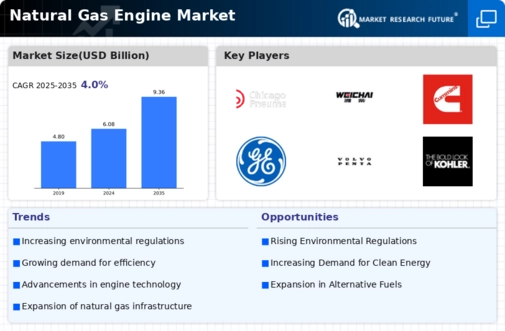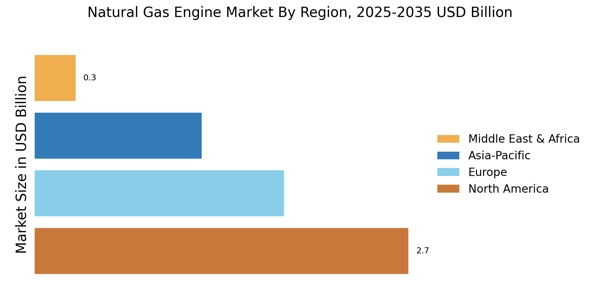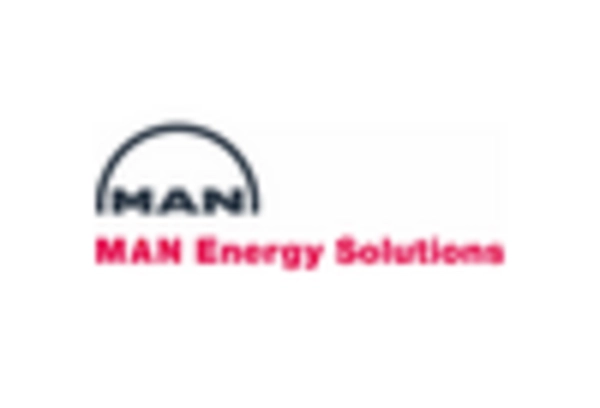Supportive Regulatory Frameworks
Supportive regulatory frameworks are crucial for the growth of the Natural Gas Engine Market. Governments worldwide are implementing policies that promote the use of natural gas as a cleaner alternative to traditional fuels. Incentives such as tax breaks, subsidies, and grants for natural gas engine adoption are becoming increasingly common. These regulations not only encourage manufacturers to develop natural gas engines but also motivate consumers to switch from conventional fuels. For instance, several countries have set ambitious targets for reducing greenhouse gas emissions, which further supports the transition to natural gas. As these regulatory frameworks evolve, the Natural Gas Engine Market is expected to thrive, driven by both policy support and market demand.
Expansion of Natural Gas Infrastructure
The expansion of natural gas infrastructure plays a pivotal role in the growth of the Natural Gas Engine Market. Enhanced pipeline networks and distribution systems facilitate the availability of natural gas, making it a more accessible fuel option for various applications. Recent investments in infrastructure development have led to increased supply and reduced costs, thereby encouraging the adoption of natural gas engines across multiple sectors. For instance, the transportation sector is witnessing a shift towards natural gas-powered vehicles, supported by the establishment of refueling stations. This infrastructure expansion is expected to bolster the Natural Gas Engine Market, as it provides the necessary support for widespread adoption and utilization of natural gas as a primary energy source.
Rising Fuel Prices of Conventional Fuels
The Natural Gas Engine Market is benefiting from the rising fuel prices of conventional fuels such as gasoline and diesel. As these prices continue to escalate, businesses and consumers are increasingly looking for cost-effective alternatives. Natural gas, being more affordable and abundant, presents a viable solution. The price advantage of natural gas engines can lead to significant savings in fuel costs, making them an attractive option for fleet operators and industrial users. Recent analyses indicate that natural gas can be up to 30% cheaper than diesel, further incentivizing the transition to natural gas engines. This economic factor is likely to drive the growth of the Natural Gas Engine Market as stakeholders seek to optimize their operational expenditures.
Technological Innovations in Engine Design
Technological innovations in engine design are significantly influencing the Natural Gas Engine Market. Advances in engine efficiency, performance, and emissions control technologies are making natural gas engines more competitive with traditional fuel engines. Innovations such as turbocharging, advanced fuel injection systems, and improved combustion processes are enhancing the overall performance of natural gas engines. These developments not only improve fuel efficiency but also reduce harmful emissions, aligning with stricter environmental regulations. As manufacturers continue to invest in research and development, the Natural Gas Engine Market is likely to witness a surge in the introduction of high-performance natural gas engines, catering to diverse applications across various sectors.
Increasing Demand for Cleaner Energy Solutions
The Natural Gas Engine Market is experiencing a notable surge in demand for cleaner energy solutions. As environmental concerns intensify, industries are increasingly seeking alternatives to traditional fossil fuels. Natural gas engines, known for their lower emissions compared to diesel and gasoline engines, are becoming a preferred choice. According to recent data, the market for natural gas engines is projected to grow at a compound annual growth rate of approximately 5.5% over the next few years. This shift towards cleaner energy not only aligns with global sustainability goals but also enhances operational efficiency for businesses. Consequently, the Natural Gas Engine Market is poised for substantial growth as more companies transition to environmentally friendly technologies.


















Leave a Comment